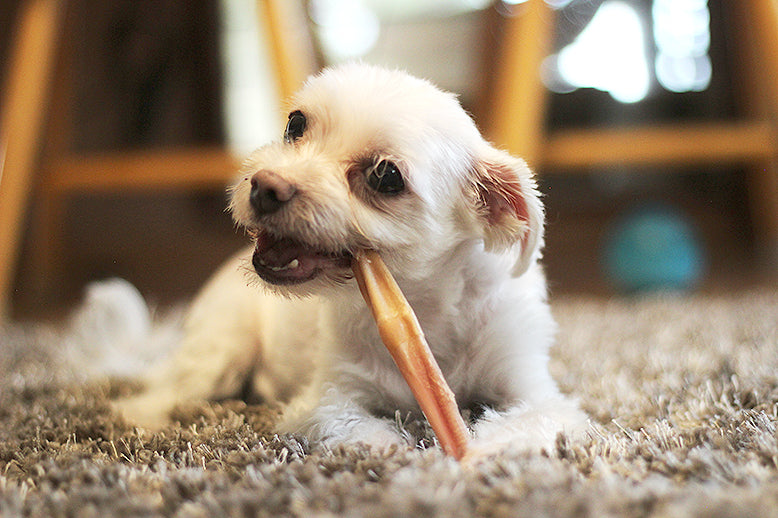My shopping cart
Call us at 888-424-4602 or email us at info@tuesdaysnaturaldogcompany.com for questions about your order status.
Your cart is currently empty.
Continue Shopping
Are bully sticks made in the USA identical to those made in Brazil? You may be surprised to find that there are several key differences depending on where a bully stick is made!
Nutrient Content of Bully Sticks
In Brazil, cattle are generally grass fed. This means that after getting weaned off of milk, the animal eats grass (which is their natural diet) for their entire life, and are not supplemented with a grain-based diet. Meat from grass fed cattle have a more appropriate omega 3 to omega 6 fatty acid ratio, whereas meat from grain fed cattle tend to be much higher in omega 6 fatty acids (which are inflammatory when consumed in excess amounts.)
A similar term, "grass finished", is similar to "grass fed", however, that animal may have been fed grain at some point in their life. In this case, a more accurate description would be "Grain Fed, Grass Finished". Beef that is grass finished will not have the same nutritional benefits as beef that was 100% grass fed.
In the USA, the majority of cattle are grain fed, or at least grain finished (i.e. they start off grazing on pasture, but are sent to a feedlot which is where they’ll reach their final weight). Grain based diets are made of corn, soy, and other inexpensive ingredients that have a high energy density. These types of diets are high in omega-6 fatty acids. When a cow is fed primarily corn/soy, rather than grass, they have a lot more fat deposited in their tissue, and this fat will not have the correct omega 3 to omega 6 fatty acid ratio.
Why does the omega-3 to omega-6 fatty acid ratio matter? When a diet is deficient in omega-3 fatty acids, there are implications that it may trigger diseases such as inflammatory and autoimmune disease, cardiovascular disease, cancer¹, and obesity². A diet with the proper omega-3 to omega-6 fatty acid ratio is essential for good health and longevity.
While a bully stick sourced from grass fed beef is not a magical elixir, carefully selecting or formulating your dog’s diet will go a long way in promoting your dog’s health. This includes everything your dog eats, whether it’s kibble, canned food, commercial raw, homemade raw, homecooked, and even treats, chews, and table scraps.
Texture and Thickness of Bully Sticks
Grain fed beef bully sticks are about 11% fat, whereas a bully stick from grass fed beef is 0.5% - 5% fat - so there’s a significant difference! This means that a bully stick from grain fed beef will be a lot more greasy than a bully stick from grass fed beef. This is something to consider if you’re trying to control the amount of fat your dog consumes, or even if you’re worried about your dog leaving a mess or stain on the furniture/carpet while they are eating the bully stick.
In the USA, cattle are slaughtered at under 36 months of age, and they are castrated early (so they are known as “steer”, rather than “bulls”) so they don’t have the hormones to develop the way that an intact bull can develop. When animals are housed in densely packed feedlots, they need to be castrated otherwise aggression towards animals would be a prevalent issue.
In Brazil, cattle are slaughtered at 40 months of age, and they are left intact longer. Because cattle in Brazil are raised on pasture, rather than in compact feedlots, they have much more open space available to them, and aggression between animals is less of a concern with producers. The hormones present in gonads aren’t only involved in reproduction, but growth and development. These intact animals can develop properly, unlike an animal that has been castrated at a young age.
Bully sticks from steer will be a lot skinnier and “wrinkly” compared to a bully stick from an intact bull, which will be much thicker and denser. If you’re looking for a long lasting chew that can stand up to tough chewers (like Labradors, German Shepherds, etc), a true bully stick would be a better selection over a steer stick. If you have a dog who can’t chew on objects that are too hard, a steer stick may be a better selection.

Were any rainforests cut down because of bully sticks made in Brazil?
The Natural Dog Company is committed to building a supply chain that is completely deforestation free. Read about what we’re doing here.